Keywords
Rainbow trout; Salmonoid Fish; Farming; Production
Introduction
The rainbow trout (Oncorhynchus mykiss Walbaum 1792) is undisputedly the most widely introduced and cultured salmonid fish across the globe, besides being extremely popular as a sport fish and an experimental fish (Ortega and Valladares, 2015). Highly oxygenated cold freshwater excellent for rainbow trout is naturally abundant in the mountainous regions of India and hence it was introduced in the early 20th century during the British colonial rule for developing recreational fisheries (Singh and Lakra, 2011). Eventually over the years, the exotic rainbow trout has become the most relevant and remunerative coldwater fish farmed in Indian uplands and trout culture is garnering more significance as a source of employment, food security and income generation. The biological characteristics that make rainbow trout truly appealing for aquaculture are rapid and high growth potential, ease of captive breeding, robustness of fry at first feeding, ability to withstand high density culture conditions without compromising growth and welfare standards, nutritionally rich flesh and tolerance to a wide range of environmental variables (Pandey and Ali, 2015). Based on these advantageous traits, concerted research and development efforts to expand and intensify rainbow trout production are continually undertaken by the ICAR-Directorate of Coldwater Fisheries Research, in partnership with concerned Fisheries Departments of trout producing hill states. In this milieu, the following article aims to inform the readers about the scientific progress made in rainbow trout farming and draw attention towards a meaningful outlook concerning the challenges to overcome while framing strategies to augment rainbow trout production in India (Figure 1).
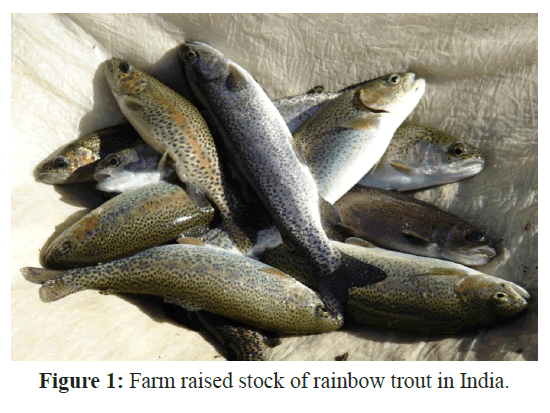
Figure 1: Farm raised stock of rainbow trout in India.
International and National Production Scenario of Rainbow Trout
Aquaculture production of rainbow trout is being carried out in several parts of the world (South America, Europe, Asia, Africa and Oceania) outside its native range in North America. According to FAO FishStat, more than 75 countries are officially represented in the rainbow trout production statistics. In 2013, the annual global aquaculture production of rainbow trout amounted to above 814 thousand tons, a radical increase from a meagre 4400 tons in 1950 (Figure 2). The top trout producing countries were Iran, Chile, Turkey, Norway and Peru, together contributing nearly 64 percent of the total production (Table 1). Further signalling an important regional shift, the last decade (2003-2013) witnessed a dramatic upward swing in rainbow trout production in Iran, Turkey, Peru, China and Russia (200 to 1000 percent increase). These changes can be attributed to well strategized governance and utilization of available natural resources. For instance, Iran has increased its annual trout production volume from less than 1000 tons in 1993 to almost 144 thousand tons in 2013, supported by an impressive increase in productivity from below 10 kg to 40 kg per m2 pond area. Among India’s neighbours, China, Nepal and Afghanistan (with annual trout production of 28991, 180 and 150 tons, respectively, in 2013) features in the FAO list of rainbow trout producing countries. The demand driven increasing production volume in many countries assures a prosperous future for the farming of rainbow trout.
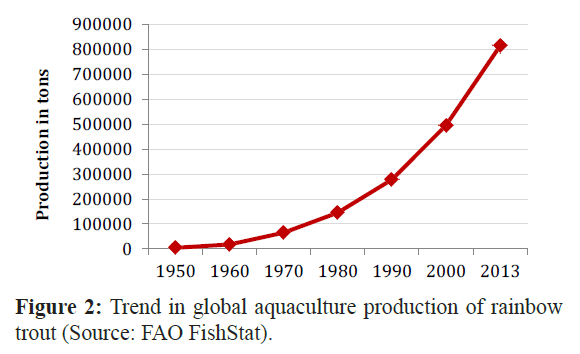
Figure 2: Trend in global aquaculture production of rainbow trout (Source: FAO FishStat).
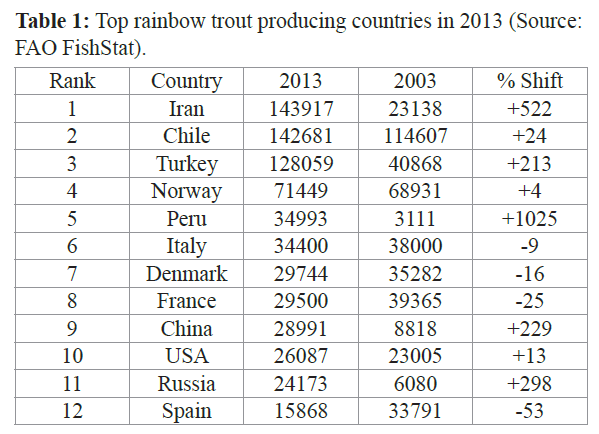
Table 1: Top rainbow trout producing countries in 2013 (Source: FAO FishStat).
India is surprisingly not included in the FAO list of rainbow trout producing countries. Nevertheless, rainbow trout has an obvious history of introduction in the north-west, peninsular and north-east hill states of India (Pandey and Ali, 2015). Techniques for propagation (breeding and rearing) is well established and infrastructure facilities to farm raise rainbow trout is operational in 62 government trout farms and 660 private trout production units distributed across the states of Jammu & Kashmir, Himachal Pradesh, Sikkim, Arunachal Pradesh, Uttarakhand, Tamilnadu and Kerala. Over the past decade (2004-2014), annual trout production in India has increased fourfold from nearly 147 to 602 tons, with predominant contributions from Jammu & Kashmir, Himachal Pradesh and Sikkim. There was four fold growth and annualised increase of 31% in trout production during the last decade. Further expansion of rainbow trout farming and intensification of production requires commercial involvement of private entrepreneurs’ and improvements in input quality (seed and feed) and governance (Figure 3).
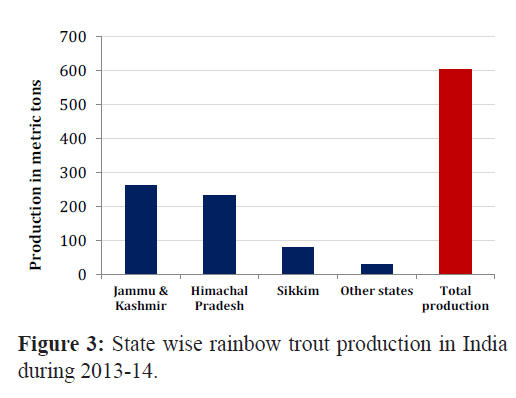
Figure 3: State wise rainbow trout production in India during 2013-14.
The Present and Future of Rainbow Trout Husbandry in India
The successful practice and science behind the confined farming of rainbow trout to yield profit involve various intricate aspects ranging from site selection, farming system, mass seed production, balanced nutrition, health management, farm operation, post-harvest processing and marketing economics. Herein, the DCFR R&D endeavours to address the forthcoming challenges and prospective solutions are discussed in the Indian perspective.
Site selection
We have undertaken GIS based mapping studies for assessing the suitabe areas/locations for rainbow trout farming is considering it as one of the most significant ways to maximizing rainbow trout farming and minimizing environmental impact in a planned way. This is usually based on survey and complete investigation of the site with respect to the availability of suitable water (volume and chemistry), hydrodynamics (water flow), soil quality (permeability and consistency related to engineering), topographic features (slope), meteorological data (climate), land use patterns and economic viability in construction and operation of the farm. To ensure sustainability, predictions of socio-economic and demographic development in the progressive ambience of our country and the possible impact of global warming may also be considered. In our study consideration has also be given to exercise caution while selecting suitable sites in access restricted geographical terrains of Indian hill states, to avoid elevated cost of production (expenses related to transportation of farm inputs and outputs) and short supply of skilled manpower.
Rainbow trout farms in India mostly depend on cold fluvial surface waters, so the volume of available water is known to vary considerably according to seasons. Water supply may reduce drastically in dry seasons, while heavy rains often cause floods. Therefore, seasonal and daily fluctuations in water quantity and quality have been considered predetermined to ensure a minimum water supply of 600 litres per minute for each tonne of trout produced, with no extreme rise or fall in temperature. The eventual carrying capacity of the trout production system could be decided based on the minimum quantum of water available. In flood prone areas, farm construction to be planned at elevated zones with a service canal. The variations in hydrodynamic state (flow or movement) of the water source to be precisely measured using current meters or acoustic Doppler current profiling technology.
Remote sensing and geographical information system (GIS) based spatial decision support system is a contemporary computational tool used to assess the suitability and sensitivity of an area to aquaculture activities (Figure 4). It involves the process of data acquisition (with accurate GPS positioning), encoding, storage, retrieval, analysis and visual display (as high resolution maps that represents ground reality). The real power of GIS is its ability to link many diverse and complex factors such as resource availability, climate, topographic features, conflict and trade-off between different economic activities, land use and access to existing infrastructure. GIS based time series analysis could be used to even predict future scenarios. ICAR-DCFR has pioneered the application of spatial decision support system by generating GIS based site suitability maps for rainbow trout culture in Sikkim and Uttarakhand.
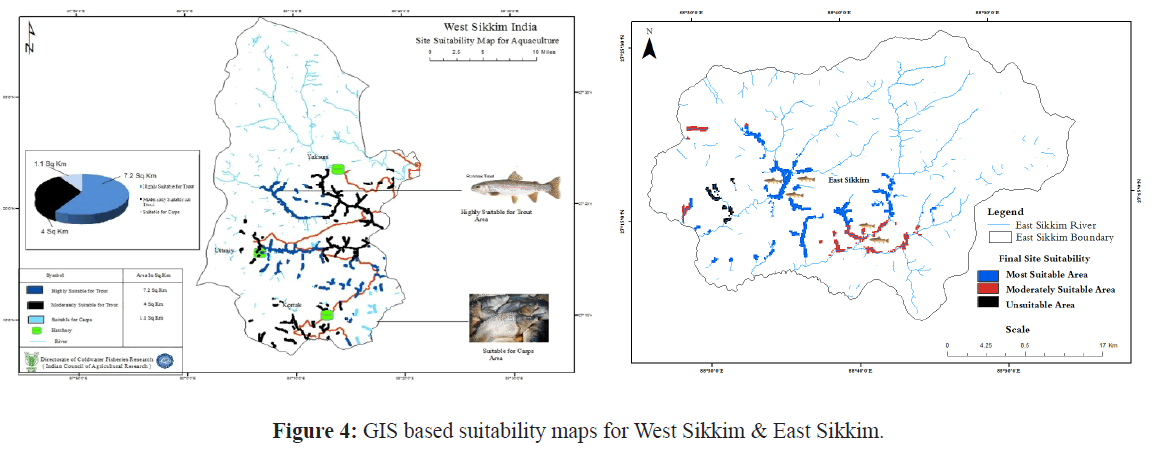
Figure 4: GIS based suitability maps for West Sikkim & East Sikkim.
Production systems
Throughout the world, rainbow trout is conventionally farmed in two ways, freshwater based production in flowing water systems (earthen ponds, concrete raceways or tanks) or seawater based production in marine offshore cages (after an initial freshwater phase). The former is adopted in most of the European, North American and Asian countries, whereas the latter is prevalent in South American and Scandinavian countries. As the coldwater expanse of India is land locked, the scope of trout production is hitherto limited to land based systems. Nevertheless, open water cage culture in inland lakes and reservoirs is a potent option.
The type of system deployed for rainbow trout farming varies with the developmental stage of fish. Typically, glass or fibre reinforced plastic tanks are used during the initial rearing (hatchery and nursery phase) and concrete structures of different shapes (raceway or circular) or earthen ponds paved with stones are used for grow out. The flow through systems require higher throughput of good quality freshwater, because stocking densities depend upon water flow and quality (temperature and dissolved oxygen content). Raceways are usually arranged in series and water flow is gravity driven, flowing from one to another with a small drop between them. Nevertheless, the major constraints involved in these systems are the excessive use of water and the high capital investment required during establishment. Water usage can be reduced by converting the traditional flow through system into recirculating aquaculture system (RAS). ICAR-DCFR has laid emphasis on such advancement by initiating a large scale outdoor closed recirculation system for rainbow trout grow out at its Chirapani field centre (Champawat, Uttarakhand); with various chemical and biological water treatment technologies. At the same time, efforts are being made to minimize capital and operational expenses in a trout farm by engineering inexpensive technologies such as low cost raceways (FRP modules or lining earthen ponds) and low head water recycling.
In order to intensify rainbow trout farming in the evolving context of limited land and water resources in India, elementary changes are warranted to bridge traditional and modern practice with respect to plan, design, layout, construction and supporting technologies. The relative performance of different trout production systems has to be evaluated by life cycle assessment based on resource utilization, quantitative output and environmental impact. On the other hand, it is also imperative to diversify culture systems and make the most out of the coldwater reservoirs and lakes in India via open water cage culture. When suspended in water columns with sufficient depth and water movement, cages transcend the common risks involved in land based systems such as water shortage and depleted water quality. Moreover, well designed cages have proven to be the cheapest way to farm raise rainbow trout.
Seed production
Being a well domesticated fish, rainbow trout can spawn successfully in captivity at water temperatures between 2 to 15°C. The timing of gonadal recrudescence, maturation and spawning is mainly influenced by seasonal changes in day length (photoperiod). The rainbow trout population in India usually spawns in autumn winter (November to January), associated with decreasing water temperatures and day length. Under normal conditions, one batch of eggs is produced each year and stripped on a single occasion. Each female can shed anywhere from 1000 to 4000 large eggs (with an average fecundity of about 2000 eggs per kilogram body weight). The normal stripping practice is to run off eggs from multiple females and fertilize it with milt from a single male fish. The time required for fertilized eggs to develop and hatch primarily depends on water temperature (more than 60 days below 6°C, around 40 days at 9°C and less than 25 days above 12°C). In the initial stages of embryonic development the zygote are extremely sensitive to handling, but after the closure of blastophore the eyed ova can be transported successfully. In conventional hatcheries, eggs are incubated indoors in trays supplied with upwelling water. Hatching success is typically above 90 percent. At hatching, the fry are attached to a large egg-yolk (yolk-sac fry or alevins) that will sustain them until the time when the buttoned up fry come to the water surface searching for exogenous feed (swim-up fry stage). Compared to other farmed fish species, the fry of rainbow trout are relatively large at first feeding and readily accept artificial feed. This gives them a positive edge in hatchery production of robust fry and fingerling.
At present, there are 32 government affiliated rainbow trout hatcheries in India, with an estimated production capacity of 13 million eyed ova. The total production of eyed ova during 2013- 14 was nearly 10.2 million, out of which 80 percent was accounted by the state of Jammu & Kashmir alone. However to progress and maintain regular supplies of high quality eggs and fry, it is essential to promote private entrepreneurs owned hatchery units in different trout farming regions. The effectiveness of such hatchery projects in supporting the expanding rainbow trout production will be profoundly affected by the conditions under which the brood fish are maintained, the genetic characteristics of the selected brood stock and manipulations of spawning. Recently in India, there are serious concerns on the productive quality of available seed related to genetic fatigue caused by repeated inbreeding. To overcome the challenge, ICAR-DCFR has made reliable efforts to characterize the genetic variability in different rainbow trout stocks using DNA marker technologies and to lay the base for genetic improvement programs (Barat et al. 2014). Likewise, successful attempts have been made in cryopreservation of trout spermatozoa from superior males for upgrading future stocks. Stepping up further, initiatives have been taken to establish a rainbow trout brood banking facility that will support genome based comprehensive selective breeding programs for productive traits (growth, food conversion and flesh quality). Another prevalent menace in trout farms is the precocious maturation or early onset of puberty that reduce somatic growth, market value and returns to farmers. In order to eliminate this problem, the Directorate has committed to develop reproductively sterile triploid stocks of rainbow trout by chromosomal manipulations of newly fertilized eggs. Other significant interests that aim to sustain and enhance trout production in India are the introduction of resource (land and water) conscious hatchery facilities such as vertical sheath incubators, photoperiod manipulation of spawning time to make eggs available year round and development of all female stock.
Nutrition, feed and feeding
In its natural habitat, the rainbow trout is a typical carnivore that feeds on aquatic invertebrates and smaller fishes. So their predominant dietary intake is high quality protein and they are more prone to use dietary amino acids as the major source of metabolic energy. The digestive machinery of trout (J-shaped acid stomach, pyloric caeca, short intestine and a full array of enzymes) is correspondingly more suited to process protein rich animal matter than plant products. Early feed formulations for farmed rainbow trout usually reflected the above observations with maximum inclusion of animal protein (Table 2). But, the declining availability and rising costs of the choice ingredients (fish meal and oil) have forced progressively higher inclusion of plant ingredients in trout feed. Irrespective of the changing trends, the nutritional requirements of rainbow trout is mostly well defined and remain the same (Table 2).
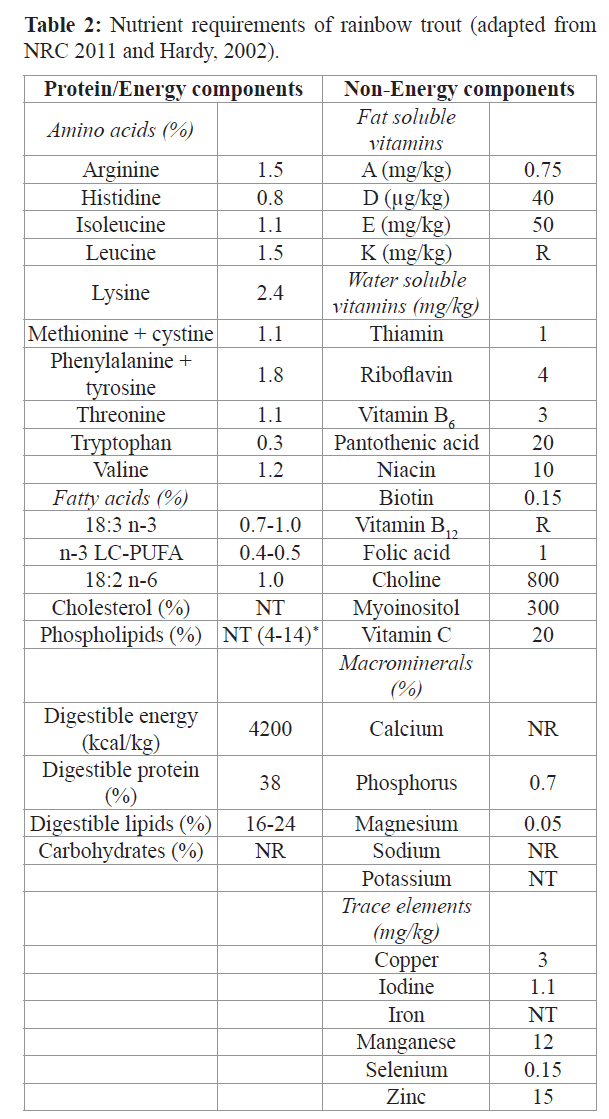
Table 2: Nutrient requirements of rainbow trout (adapted from NRC 2011 and Hardy, 2002).
A good feed should be palatable, digestible and well balanced to meet all the nutrient requirements of the fish for maintenance and growth. Considering the fact that feeding is the most expensive component in carnivorous fish farming, the characteristics of the compound feed (composition, efficiency and cost); together with the method of feed preparation and feeding strategies (ration and frequency) determine the profitability margins of a trout farm. Present trout feeds contain fish meal, fish oil, oilseed meals, protein concentrates and other by products derived from cereals. However, sustainability of the feed depends on the continuous supply of ingredients in required quantity and quality at competitive prices. In this context, successful efforts have been made to substantially reduce the amount of marine ingredients used by substituting locally derived alternate ingredients (plant based and rendered products). Likewise, evaluation of new ingredients that can alone or in combination replace fish meal and fish oil without compromising fish health or productivity should be carried out using frontier tools such as near infrared reflectance spectroscopy. In terms of feed manufacturing, use of extrusion technology has aided the production of high energy feed with different buoyancy (floating, slow sinking and sinking pellets) and results in wear resistant hard pellets than traditional steam pelleting. Under optimum rearing conditions and with good feeding practices, the best nutrient-dense feeds can yield feed conversion ratios of 1.2 to less than 1. Moreover, application of novel feeding practices such as phase feeding (use of tailor made feeds to influence product quality and farm effluents) can impact environmental compliance and consumer acceptance. Trout production in India has to be propped up with similar practical innovations in feeding strategies and high performance feed formulations.
At present, supply of compound feed for most of the trout farms originates at three well equipped feed mills operated by state fisheries departments (two in Jammu & Kashmir and one in Himachal Pradesh), with an installed capacity of less than 10 tons per day. Different types of feed (starter crumbles, grower, finisher and brood stock pellets) are produced depending on the developmental stages. But unlike commercial trout feed manufacturers of other countries, feeding charts are not made available. It is necessary to determine the recommended daily quantities of feed based on rearing conditions and prepare a systematic feeding schedule. As a thumb rule, younger fish should be fed more frequently than older ones, frequency of feeding should be increased with the temperature of the rearing water and size of feed particles should allow the fish to comfortably grab and swallow them. The use of automatic (continuous belt feeder) and demand feeders should be taken up to aid manual feeding. For trout farms situated in access restricted remote places, where commercial compound feeds are not readily available, ICARDCFR recommend farm made feed mixtures that uses locally available slaughterhouse by-products, fish offal and wastes (fish silage). The benefit of adding cost-effective dietary supplements to such feeds could be evaluated.
Health management and disease surveillance
In a rainbow trout farm, the risk of disease occurrence is directly related to the intensity of production and it is mostly determined by the interaction between stress factors prevailing in the rearing environment, presence of pathogens and immune response of host. Incidence of disease can often cause substantial losses and economic burden to the farmer. Good husbandry practice is the most economical way to fight pathogens, prevent disease contraction and improve fish welfare. This integrates sanitation, good water quality, high quality feed, stress free handling and elimination of disease vectors. Likewise, monitoring the behaviour of the fish is the best way to check their welfare. Palpable signs of disease are loss of appetite (reduced feed intake), gathering at the water inflow, gasping for air at the surface, other abnormal behaviour (whirling, floating and forced movements) and external indications (body discolouration, wounds, fin erosion, stiff eyes and changes in mucus secretion).
Domestication and culture intensification has paved the way to encounter pathogenic, environmental and nutritional diseases in rainbow trout farming. The commonly occurring diseases in Indian trout farms could be associated with poor management of water quality, abnormal environmental fluctuations (oxygen depletion and supra-optimal temperature), clogged gills, physical injury, dietary deficiencies and accidental intake of dietary toxins. Nevertheless, diseases due to facultative and obligate pathogens are also ubiquitous. For instance, fungal infections due to Saprolegnia spp.; bacterial diseases due to Aeromonas spp., Pseudomonas spp., Vibrio spp. and Lactococcus spp.; and parasitic infestations due to Costia, Myxosporidium, Ichthyophthirius and monogenean flukes are frequently reported in farms and hatcheries. So far the good news is that devastating viral diseases such as infectious pancreatic necrosis, infectious haematopoietic necrosis and viral haemorrhagic septicaemia have not been found. Therefore, if and when improved strains of rainbow trout eyed ova are imported in the near future, extreme caution should be exercised to ensure their absence.
Well described clinical signs and symptoms accompany different diseases of rainbow trout and that often helps in early diagnosis and cure. ICAR-DCFR has been at the forefront of developing advanced diagnostic tools for bacterial and viral diseases based on biochemical assays, PCR amplification, dot ELISA, cell culture screening for cytopathic effect, counter immunoelectrophoresis and sequence independent single primer amplification. Besides, initiatives have been taken up to create a comprehensive electronic database that links data pertaining to disease occurrence, mortality patterns, geographical location and rearing environment from rainbow trout farms across the country. This benchmark tool will support real-time epidemiological modelling that could provide early warning of disease outbreaks and allow precautionary actions in the future. More introspection and progress are required with respect to biosecurity measures, diagnostic methods and disease control (drug delivery system, antimicrobial molecules and vaccines). The mode of controlling diseases should never risk consumer safety, so the unwarranted use of antibiotics and other chemotherapeutic treatments should be effectively restrained and regulated.
Farm operation
The productivity, success and endurance of a rainbow trout farm invariably depend on the day to day operation. The primary responsibility is to ensure optimal rearing conditions for the different age groups of rainbow trout, which includes proper maintenance of water flow, quality, fish density, grading, feeding, cleaning and harvesting. Continuous flow of clear, clean and oxygen rich water must be sustained to bring enough oxygen and carry away wastes (faeces and uneaten feed) from the rearing system. The velocity of water flow should be kept proportional to the size of the reared fish. It will be ideal if water temperature remains in the range of 10-18oC for as long as possible, but practically it is not possible to maintain constant water temperature in surface water fed trout grow out farms. Nevertheless, heating devices are an option in hatcheries for increasing water temperature to facilitate fast growth. The rearing water must contain as much dissolved oxygen (near saturation) as its temperature allows. Instead of aerators or oxygen injectors, simple alterations in the water supplying devices using perforated pipes, cascade arrangements and spouting fountains can increase the oxygen carrying capacity of the arriving water. At times of high flow following rain, upward flow screens or filters must be kept in the water intake channel to exclude silt (especially before hatchery use). The inlet and outlet water quality should be monitored regularly to recognize the build-up of harmful solids and gases in the rearing system.
The stocking density of the fish should be adjusted based on the flow rate, dissolved oxygen content and temperature of the rearing water. In a serial arrangement, upper raceways should be stocked at higher densities than lower raceways as water quality decreases along the flow. Similarly, freshwater should be used first in raceways holding younger fish, from where water can serially flow into raceways with older age groups of fish. During the rearing cycle, grading (screening and regrouping based on size) of the on-growing stock must be done in a scheduled manner to avoid uneven size distribution, aggressive behaviour and cannibalism. Manual and mechanised grading grids are commercially available to ease the task. It is also very essential to maintain the highest possible standard of hygiene by thoroughly cleaning and disinfecting hatchery-farm equipment, rearing troughs, tanks and raceways, at regular intervals. Dead fish or eggs must be removed immediately. Feed should not be stored improperly for prolonged duration. Together, these steps can prevent disease outbreaks.
Rainbow trout farms in India seriously lack standard documentation procedures that could provide reliable data on farm operation, total production, productivity, growth, feed conversion ratio and economics. Hence, progressive farmers’ should be encouraged to note daily farm activities in prescribed formats for self-assessment and for official registration.
Harvest, processing and marketing
Generally, it takes 12-18 months of rearing to harvest table or pan sized (300-400 g) rainbow trout. However, harvest size of farmed trout varies with market demand (small or large) and intended final product (fresh, smoked or filleted). The fish are usually starved for sufficient time before harvest-slaughter to evacuate the gut contents. While handling the harvested fish, care must be taken to avoid damages that accelerates deterioration and spoils appearance. If the farm is situated in remote places, simple on-site primary processing such as cleaning, gutting and chilling becomes an economic necessity before the extended transport. At present in India, fresh fish market is large because of the taste preferences and flesh characteristics (mild flavoured, soft and delicate). But in the sales spectrum, it is always profitable to do value addition and push the product as far up-market. A wide range of processed products can be prepared from trout based on market demands. Primary processing yield products (chilled or frozen fish; whole or gutted or filleted) that increase marketability, whereas secondary processing yield products (dried, smoked, spiced or breaded) that adds value. Value-added products can increase revenues without the need of additional production. Nevertheless, as of now, there is no exclusive processor for rainbow trout products in India.
The total trout production of India is marketed mostly within and around the farming regions. Direct sale to local markets (wholesalers, retailers and consumers) is common in terms of marketing. Since the local demand is greater than the supply, the production is market driven at this stage. But with increasing production, marketing channels should target hospitality (upscale restaurants) and retail (supermarkets) industries in larger urban areas. Further considering the isolated locations of trout farms, it will be worthwhile to develop a trout supply chain with strategically placed cold storages. Growing market demand and secure pricing will generate opportunities and fuel commercial scale expansion of production. On the other hand, by building a lucrative relationship with tourism industry, farm raised rainbow trout could also find another potential market in the form of fee fishing operations.
Concluding Remarks
Rainbow trout farming is relatively rudimentary in the deep rooted aquaculture scenario of India. However, it is rapidly gaining prominence as the most ideal option to sustainably use the vast cold water resources in the mountainous regions. It also provides regular employment and stable income to the economically underprivileged inhabitants of the Indian uplands. Further expansion of trout culture must overcome several challenges such as seasonally limited water resources, unfavourable environmental conditions (high summer temperatures exacerbated by global warming), inadequate supply of seed (fry and fingerlings) and feed, inflated costs of transportation, restricted access to financing and escalating demand of resources (land and water) for urbanisation. Therefore, multi-pronged strategies are needed to stimulate horizontal and vertical enhancement of trout production in India. Especially, the productivity of existing operations should be progressively augmented by ushering in scientific advances made in trout farming and marketing. The focus should be on:
• Correct choice of new farm sites and best use of water in the most economical way.
• Customizing farm operation based on localised situations.
• Research in the areas of genetic improvement, high performance feeds and production technologies that could ensure sustainable increase in trout production.
• Vertical integration of production systems to form a ‘culture chain’ with specialist private stakeholders exclusively involved in hatchery, grow-out, feed and marketing.
• Setting up cluster farming modules that will promote cooperation between farmers to share benefits in purchasing farm inputs and marketing the final output.
• Infrastructural developments to aid organized supply chains and value addition.
• Use of information and communication technology to share support services, technical know-how and market intelligence with farmers.
• Policy changes that favour farmers in terms of loans, subsidies and price fixing.
• Preparedness to adaptively respond to climate change and natural disasters.
The future beholds a low risk rainbow trout farming industry that offers rewarding returns on investment, livelihood security and copious animal protein to the food basket. In order to realize that, a feasible and effective national work plan has been drafted during the recent national consultation meet held during September 2015 on rainbow trout farming in India.
9402
References
- Barat Ashoktaru, Prabhati K Sahoo, Rohit Kumar, Javaid I Mir, Shahnawaz Ali, Rabindar S Patiyal and Atul K Singh (2014).Molecular characterization of rainbow trout, Oncorhynchusmykiss(Walbaum, 1972) stocks in India.Journal of Genetics
- nBurnell, G., and Allan, G. (Eds.). (2009). New technologies in aquaculture: Improving production efficiency, quality and environmental management. Elsevier
- nCrawford, S. S., and Muir, A. M. (2008). Global introductions of salmon and trout in the genus Oncorhynchus: 1870–2007. Reviews in Fish Biology and Fisheries, 18, 313-344
- nFornshell, G. (2002). Rainbow trout - challenges and solutions. Reviews in Fisheries Science, 10, 545-557
- nGall, G.A.E. and Crandell, P.A. (1992).The rainbow trout.Aquaculture, 100, 1-10
- nMohan, M. (2009). Breeding and grow out technology for rainbow trout in India. INFOFISH international, (5), 8-10
- nOrtega C. and Valladares, B (2015).Analysis on the development and current situation of rainbow trout (Oncorhynchus mykiss) farming in Mexico. Reviews in Aquaculture, 1-9
- nPandey N.N. and S. Ali (2015). Rainbow trout farming in India: R & D Perspective Bulletin No 23, 28pp. ICAR-Directorate of Coldwater Fisheries Research, Bhimtal
- nPandey, N. N. and Ali, S. (2012). Present status and strategies for the development of trout farming in India. In: Souvenir-Cum-Abstract Book – National Consultation on Mountain Fisheries. Directorate of Coldwater Fisheries Research, Bhimtal
- nSedgwick, S. D. (1995). Trout Farming Handbook, 6thEdn. Fishing News Books.Blackwell Science Ltd. Oxford
- nSehgal, K. L. (1999). Coldwater fish and fisheries in the Indian Himalayas: Culture. Fish and fisheries at Higher Altitudes.Asia, (385)
- nSingh A.K. and Lakra, W. S.(2011). Risk and benefit assessment of alien fish species of the aquaculture and aquarium trade into India.Reviews in Aquaculture3, 3–18
- nStickney, R. R. (2000). Encyclopedia of aquaculture.John Wiley and Sons
- nWoynarovich, A., Hoitsy, G., and Moth-Poulsen, T. (2011). Small-scale rainbow trout farming.FAO Fisheries and Aquaculture Technical Paper No. 561.












